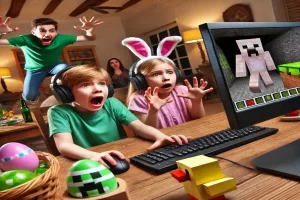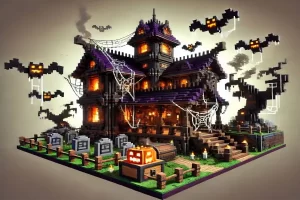Minecraft, the beloved sandbox game known for its blocky aesthetic and endless possibilities, has captured the hearts of millions worldwide. One of its greatest strengths lies in its modding community, where players can customize their experiences and expand the game beyond its original limits. This flexibility has given rise to a variety of mod genres, and one of the most exciting—though often terrifying—is the world of horror mods.
Horror mods in Minecraft tap into the game’s simple yet eerie environment, using the game’s mechanics to craft unsettling and thrilling experiences. What started as basic spooky additions has evolved over time into fully immersive, narrative-driven mods that can send chills down your spine. From creepy monsters lurking in the shadows to unsettling atmospheres and jump scares, Minecraft horror mods have grown into a genre that blends fear with the game’s unique charm.
In this post, we’ll take a closer look at how these mods have evolved, exploring the journey from simple scares to the terrifying, deeply immersive experiences they are today. Prepare to be surprised by the spooky side of Minecraft—where your creativity might just save your life!
The Beginnings of Minecraft Horror Mods
Early Concepts of Horror in Minecraft
When Minecraft was first released, it was primarily known for its charming blocky world and its focus on exploration and creativity. However, the game’s mysterious, seemingly endless world—filled with unexplored caves, dimly lit dungeons, and eerie noises—naturally lent itself to darker interpretations. Players quickly realized that the simple mechanics and atmospheric elements of Minecraft could be used to craft experiences that were far more unsettling than the game’s intended whimsical tone. It wasn’t long before fan-made mods and maps began to tap into this potential, utilizing the game’s ambient sounds, dark caves, and strange mobs to build a sense of tension and unease.
The power of Minecraft‘s horror mods lies in their ability to take the game’s mundane mechanics—like building, exploring, and surviving—and twist them into something much more sinister. Whether through subtle environmental changes or simple encounters with eerie mobs, these mods harnessed Minecraft‘s inherent mystery to create terrifying experiences that kept players on edge.
The Rise of Herobrine and Early Horror Mods
One of the first and most iconic figures to emerge from Minecraft’s horror modding scene was Herobrine. This mythical, enigmatic figure, said to be a vengeful ghost haunting the game, became the stuff of Minecraft legend. Although the character was never part of the official game, players soon began to craft mods and stories around Herobrine, turning him into a figure of terror. The “Herobrine Mod” was among the earliest examples of Minecraft horror, where the player would encounter the mysterious figure—sometimes stalking them through the game, sometimes causing strange events or disturbances.
The Herobrine myth became more than just a mod; it was a cultural phenomenon within the Minecraft community. It served as the foundation for many early horror mods, which capitalized on the fear of the unknown and the supernatural. These mods blended superstition and lore, creating an atmosphere of dread that players were eager to explore, even if they feared what they might find.
Basic Horror Maps and Resource Packs
As Minecraft‘s modding community grew, so did the creativity of its players. The next step in the evolution of Minecraft horror was the creation of custom horror maps. These maps were designed to take players through terrifying environments with specific goals, often relying on Minecraft‘s limited tools to create suspense. Whether it was a haunted mansion, a creepy forest, or an abandoned mine, the early maps found ways to exploit the game’s sparse mechanics—like dark spaces, sudden sounds, and unpredictable mob behavior—to keep players on edge.
Alongside the rise of custom maps, resource packs began to gain popularity as a tool to further enhance the horror experience. These packs could alter the game’s textures, sounds, and music, making familiar places feel unsettling and alien. For example, simple changes to the ambient soundscape, such as adding whispers, distant footsteps, or eerie music, could turn a peaceful exploration into a spine-chilling ordeal. These early mods and resource packs laid the groundwork for more complex horror experiences to come, showing how Minecraft’s basic elements could be manipulated to elicit fear and tension.
The Expansion of Horror Mods (2012-2015)
New Horror Themes and Legends
As Minecraft’s modding community continued to grow, so did the scope of horror mods. In the early days, mods focused primarily on supernatural or mystical themes, like Herobrine, but by 2012, modders began delving into darker and more complex real-world legends. Among the most notable were mods inspired by the Slender Man, SCP Foundation, and Wendigo myths.
The Slender Man mod brought the creepy figure from internet folklore into the blocky world of Minecraft. Slender Man’s tall, faceless form and ability to appear unexpectedly in dark areas made him the perfect addition to Minecraft’s already unsettling atmosphere. Players could wander through the world, unknowingly crossing paths with the tall, thin figure, or perhaps encounter his eerie whispers and the terrifying sense of being stalked.
Similarly, the SCP mods introduced the bizarre and terrifying entities of the SCP Foundation, a fictional organization housing dangerous creatures and anomalies. These mods incorporated Minecraft’s world mechanics to trap players in eerie containment areas, forcing them to face off against creatures like the infamous SCP-173, a statue-like entity that moves when not in direct line of sight.
The Wendigo, a malevolent creature from Native American folklore, was another popular addition, tapping into primal fears of cannibalism and isolation. Mods featuring the Wendigo transported players into cold, desolate environments, often set in vast forests or snow-covered wildernesses, where the fear of being hunted by the Wendigo was ever-present. By introducing these new legends, Minecraft horror mods expanded their thematic range, using Minecraft‘s mechanics and world-building potential to bring these terrifying myths to life in new and unique ways.
The Shift Toward Story-Driven Mods
Around 2013-2014, Minecraft horror mods began shifting from jump-scare-heavy experiences toward more story-driven narratives. This period marked the rise of mods that incorporated deeper lore, complex settings, and intricate plots, making the scares feel more meaningful and immersive.
Mods like The SCP Lockdown Mod took the Minecraft horror experience to the next level by blending survival mechanics with a rich, story-driven framework. In this mod, players were trapped in a mysterious facility filled with dangerous creatures and anomalies from the SCP Foundation, and the mod not only provided terrifying encounters but also intricate backstories about each SCP entity, creating an atmosphere of both dread and curiosity.
Another key example of this shift was The Twilight Forest mod, which initially presented a magical forest but slowly added darker elements to its design. As players ventured deeper into the forest, they encountered ominous creatures, corrupted environments, and unsettling lore, making it feel less like a whimsical world and more like a terrifying place where danger lurked behind every tree.
These mods proved that Minecraft horror didn’t have to rely solely on cheap scares or atmosphere—well-crafted stories and immersive worlds could engage players on a much deeper emotional level, keeping them invested in both the narrative and the terrifying moments within it.
Improved Map Design and Customization
As the horror modding community evolved, so did the technical aspects of mod design. Custom maps and environments became more sophisticated, featuring better structures, atmospheric designs, and intricate storytelling elements. Modders began pushing the boundaries of what Minecraft maps could look like, moving beyond simple spooky mazes or dark caverns to create fully fleshed-out horror worlds.
Mods started incorporating custom mobs with advanced AI that could hunt players, adding an extra layer of fear to the gameplay. These mobs weren’t just the same old Minecraft creatures—they were designed to be unpredictable, terrifying, and capable of catching players off guard. For instance, certain mods introduced enemies that would stalk the player, ambushing them when they least expected it, or using sound cues and AI behaviors that heightened the tension.
The integration of custom structures, such as haunted mansions, abandoned hospitals, or cursed towns, further added to the atmosphere. These environments often came with hidden passages, puzzles, and complex backstories that encouraged players to explore in a way that built a sense of dread. Through these improvements, modders were able to craft experiences that not only relied on the core mechanics of Minecraft but also drew players into horrifyingly immersive worlds with detailed designs and evolving threats.
By 2015, Minecraft horror mods had transformed into a thriving subgenre of Minecraft modding, with a focus on more sophisticated horror elements, from mythology-based content to in-depth stories and highly detailed maps.
The Golden Age of Minecraft Horror Mods (2016-2020)
Full-Fledged Horror Experiences
Between 2016 and 2020, Minecraft horror mods reached new heights with fully fleshed-out experiences. Mods like The Haunted Realm and The Banshee Mod offered complete, immersive horror narratives that went far beyond simple gameplay enhancements. These mods introduced intricate storylines, atmospheric settings, and character-driven plots that drew players into terrifying, well-crafted worlds.
The shift toward full-fledged narratives included not just gameplay, but also voice acting, cutscenes, and custom music. Mods began to incorporate cinematic techniques, adding a level of professionalism and immersion that had previously been unseen in Minecraft horror. Players could experience rich lore and dramatic story arcs, interacting with NPCs, uncovering mysteries, and progressing through story-based objectives—all while experiencing spine-chilling scares.
The integration of cutscenes and cinematic moments helped create tension and build suspense in a way that was previously only possible in more traditional horror games. These mods weren’t just about surviving Minecraft—they were about being actively involved in a terrifying story.
Advanced AI and Mob Behavior
One of the most significant developments in Minecraft horror mods during this period was the improvement in artificial intelligence (AI). As modders gained more experience and access to more powerful tools, they were able to create smarter and more unpredictable enemies, making Minecraft’s horror experience far more terrifying.
Mods like The Chasing Mod introduced the concept of enemies that relentlessly pursued the player, adding a layer of tension as players couldn’t simply hide or escape to a far-off part of the world. Other mods incorporated randomized enemy encounters, meaning that monsters could appear at any moment, in any location, with varying degrees of aggressiveness. This unpredictability made the experience more nerve-wracking, as players could never be sure when or where the next encounter would happen.
The enhanced AI meant that creatures could also adapt to player actions, like learning patterns of movement or finding ways to trap the player, thus elevating the horror experience and preventing players from relying on simple escape strategies.
Multiplayer Horror Mods
As Minecraft’s modding community grew, so did the desire for cooperative horror experiences. Multiplayer mods began to flourish, and by the late 2010s, several high-profile horror mods took advantage of Minecraft‘s multiplayer features, allowing players to experience scares together in real-time.
The Dark Depths and Dead Space are among the most notable examples of multiplayer horror mods that capitalized on the tension of co-op gameplay. These mods pushed players to rely on each other to survive while creating a sense of isolation and fear through their environments. In The Dark Depths, players would descend into an abandoned mine or cave system, uncovering horrifying mysteries while trying to avoid or fight off terrifying mobs. The mod’s ability to create tension between teammates—forcing players to make difficult choices, often with limited resources—added a new level of fear.
Dead Space, inspired by the popular video game series of the same name, featured tight corridors, creepy visuals, and terrifying enemies, creating an atmosphere that forced players to work together to survive while facing their fears. The multiplayer component made these mods particularly engaging, as they fostered moments of both camaraderie and panic, making the horror feel more real when players could hear each other’s voices crack with fear.
Enhanced Graphics and Immersion
Another key development in the golden age of Minecraft horror mods was the significant improvement in graphics and visual effects. While Minecraft is inherently a blocky, low-resolution game, modders began to harness resource packs, shaders, and custom textures to vastly improve the visual atmosphere of their horror mods.
With resource packs and custom textures, mods could transform Minecraft‘s world into an eerie, foreboding landscape, filled with unsettling details that added to the immersive atmosphere. Custom shaders and lighting effects were used to create darker, more oppressive environments, where shadows loomed and fog settled in. These mods could manipulate light and color to enhance the sense of dread, casting areas into almost total darkness or making environments feel claustrophobic and unwelcoming.
Additionally, mods began to use fog, rain, and visual effects like distorted textures or glitch effects to create supernatural events or unsettling moments. This attention to detail in the visual and environmental design made the horror experience in Minecraft feel even more tangible, bringing the scares to life in a way that felt both immersive and terrifying. The improvements in graphics and visual cues contributed significantly to the fear factor, proving that Minecraft could be a platform for intense, fully-realized horror experiences.
Overall, from 2016 to 2020, Minecraft horror mods reached their peak, offering players an array of terrifying experiences that blended storytelling, innovative gameplay, and atmospheric design. The combination of cutting-edge AI, multiplayer features, and enhanced visuals brought a new level of horror to the blocky world, and players could no longer dismiss Minecraft as just a family-friendly sandbox game. Instead, it had evolved into a platform for horror enthusiasts to create, share, and experience some truly chilling adventures.
Recent Trends and Innovations in Minecraft Horror Mods (2021-Present)
Integration with Other Horror Genres
Recent Minecraft horror mods have begun to push the boundaries of the genre by blending traditional horror with elements from other genres, such as survival, mystery, and adventure. These innovations bring a fresh dynamic to the modding scene, offering players more complex, multi-layered experiences that go beyond simple jump scares.
Mods like Lurking in the Shadows and The Haunting are prime examples of this trend, where the horror elements are interwoven with survival mechanics, puzzle-solving, and narrative-driven gameplay. Lurking in the Shadows introduces an unsettling atmosphere where players must uncover hidden secrets and navigate dangerous environments while dealing with hostile entities. The mod emphasizes stealth and careful exploration, as the threat of being hunted adds a layer of suspense that forces players to think strategically about every move they make.
Meanwhile, The Haunting brings in elements of mystery, where players must piece together clues, solve puzzles, and interact with spectral forces to uncover the backstory behind a haunting presence. These mods elevate the genre, offering players an experience that is part horror, part adventure, and entirely gripping. The fusion of these genres makes the horror feel more dynamic and unpredictable, keeping players engaged and immersed in a constantly evolving world.
Virtual Reality (VR) and Augmented Reality (AR) Horror
One of the most exciting developments in Minecraft horror mods has been the integration of Virtual Reality (VR), making the horror experience more immersive and intense than ever before. VR takes the blocky, pixelated world of Minecraft and transforms it into a terrifying space where players are fully immersed, feeling every jump scare, every shadow, and every eerie sound in a way that flat-screen gaming simply cannot replicate.
Mods that support VR, such as Minecraft VR Horror, offer players the chance to step inside the world of Minecraft and experience fear up close and personal. The combination of VR’s spatial immersion with Minecraft‘s unpredictable mechanics results in a truly terrifying experience—especially when monsters can appear just inches from the player’s face. VR amplifies the sense of isolation and urgency, heightening the fear factor as players are not only encountering horrors through the screen but living them in 360 degrees.
Additionally, Augmented Reality (AR) is beginning to make its mark on Minecraft horror mods. While still in its early stages, AR elements are being experimented with to bring Minecraft monsters and environments into the real world. Through the use of AR glasses or mobile devices, players could potentially interact with virtual horror scenarios while navigating their own real-world surroundings, creating a whole new level of terror by blurring the lines between reality and the Minecraft world.
Community and User-Created Horror Experiences
Perhaps one of the most exciting trends in recent Minecraft horror mods is the growing prominence of community-driven and user-created content. Rather than relying solely on professional modders, many horror mods are now collaborative efforts, with players contributing their own designs, maps, mobs, textures, and soundtracks to create shared horror experiences.
This shift has led to a more inclusive and diverse horror modding community, where anyone can contribute their own ideas and bring them to life in the Minecraft universe. Mods like The Silent Forest and Nightmare’s Edge have been made possible through collaborations between different modders, each bringing their unique skills and ideas to the table. These mods feature custom mobs, original maps, and even bespoke soundtracks that add an extra layer of depth to the horror experience.
The growing role of shared experiences in Minecraft horror modding is also a key part of this trend. Many mods now feature co-op play, where multiple players can experience the terror together. These shared horror experiences have the potential to foster deeper connections within the Minecraft community, as players come together to survive or uncover the mysteries of a haunted world. The focus on collaboration and creativity has made modding not only a technical art form but also a communal activity, turning Minecraft horror mods into a shared canvas for fright and imagination.
Overall, the recent trends in Minecraft horror mods are pushing the genre into exciting new territory, embracing innovation in both gameplay and technology. Whether through the fusion of genres, the immersive possibilities of VR, or the power of community collaboration, Minecraft horror mods continue to evolve, providing players with increasingly sophisticated and terrifying experiences. As the modding community grows, it’s clear that the future of Minecraft horror is bound to be even more thrilling and unpredictable.
Conclusion
Minecraft horror mods have come a long way since their humble beginnings, evolving from simple, jump-scare-driven maps to fully immersive, story-rich experiences that rival those of traditional horror games. Early mods, relying on basic mechanics and ambient creepiness, set the stage for what would become a thriving subgenre. As the years passed, modders pushed the boundaries of creativity, integrating complex AI, intricate narratives, and even virtual reality to create truly terrifying experiences that engage players in ways the original game never intended. From the eerie creepiness of Herobrine to the multiplayer terror of co-op mods, Minecraft horror has become an ever-evolving field that continually redefines what it means to experience fear in a blocky world.
What makes Minecraft horror mods so compelling is the game’s inherent flexibility and the creativity of its modding community. The game’s open-world structure and modding tools have allowed creators to build horror experiences that range from atmospheric, narrative-driven adventures to chaotic, survival-focused nightmares. Minecraft has provided a platform where modders can experiment and break the mold, allowing them to blend genres, incorporate new technologies like VR, and tell terrifying stories through collaborative efforts.
As Minecraft continues to grow, the possibilities for horror mods are limitless. Whether you’re a long-time fan of the genre or a newcomer looking to experience the scares, there’s always something new waiting to be discovered. So, dive into the rich history of Minecraft horror mods, explore the terrifying worlds they’ve created, and share your own favorite horror moments with the community. What scares you the most in Minecraft? We’d love to hear your thoughts and experiences—share them with us and continue to explore the chilling possibilities of Minecraft horror!




